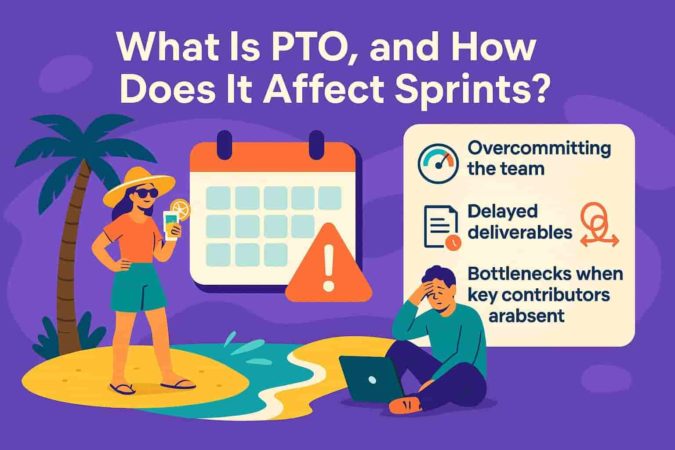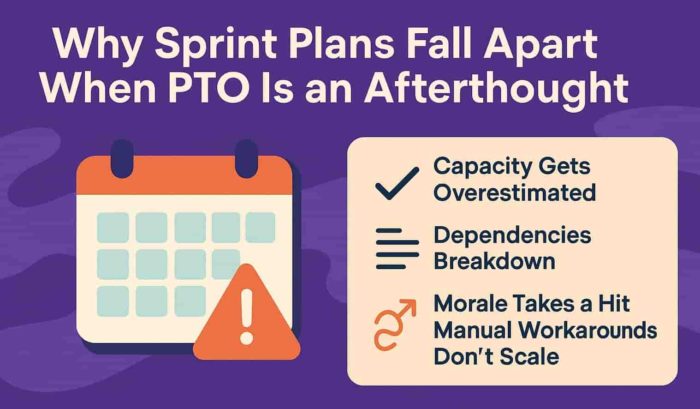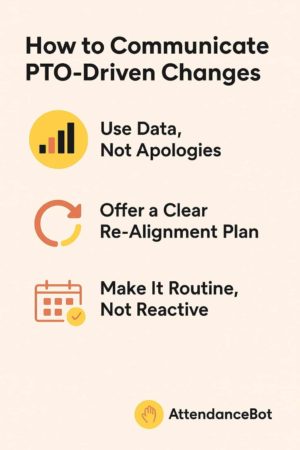Every sprint starts with the best of intentions. The backlog is refined, the team commits confidently, and the burndown chart is ready to tell a satisfying story. But then someone takes a day off. And then another. Before you know it, your tightly scoped sprint is fraying at the edges – tasks are rolling over, velocity plummets, and standups start to sound like confessionals.
Time off is a normal part of work and is essential for the long-term health of the team. But when PTO isn’t factored into sprint planning from the get-go, it creates a ripple effect that derails delivery and frustrates everyone involved. This blog unpacks how unplanned (or even poorly planned) PTO can sneak up on your agile team – and what you can do to keep sprints on track, even when key players are out.
What Is Sprint Planning, and Why Does It Matter?
Sprint planning is a core ceremony in Agile frameworks like Scrum. It’s where the team decides what work can be completed in a fixed time period – typically one or two weeks – based on priorities, capacity, and historical velocity. The goal is to create a realistic plan that helps the team focus and deliver value in a short, iterative cycle.
A sprint plan typically includes:
- A clearly defined sprint goal
- A list of prioritized tasks (or user stories) pulled from the backlog
- Capacity estimates based on team availability
- Commitments from team members on what can be completed
What Is PTO, and How Does It Affect Sprints?
Paid Time Off (PTO) includes vacation days, personal time, and other forms of leave that allow employees to step away from work while still getting paid. While PTO is essential for employee well-being, it can significantly impact team output, especially when it overlaps with a sprint.
When time off isn’t accurately accounted for during planning, the result is often:
- Overcommitting the team
- Delayed deliverables
- Bottlenecks when key contributors are absent
- Team frustration and loss of morale
In short, ignoring PTO when building a sprint plan is like ignoring weather forecasts when planning a hike – you might be fine, but you’re probably in for a rough surprise.

Why Sprint Plans Fall Apart When PTO Is an Afterthought
In theory, sprint planning is a clean, data-driven process. You’ve got your historical velocity, your refined backlog, and a team ready to commit. But that plan assumes something deceptively simple: that everyone will be available. Once PTO enters the picture – especially last-minute or unaccounted-for leave – the whole structure wobbles.
Here’s why:
1. Capacity Gets Overestimated
If PTO isn’t factored into planning, your velocity estimates are inflated from the start. You’re setting goals based on ideal capacity, not actual team availability. This leads to overcommitment, missed deliverables, and stressed-out devs scrambling to pick up the slack.
2. Dependencies Breakdown
Agile teams work cross-functionally, and often one person’s task is a prerequisite for the next. When a key contributor is out, say, your only QA engineer or the frontend dev on a major feature, it creates a bottleneck no one accounted for. Work stalls, blockers pile up, and your carefully plotted sprint burndown graph flatlines.
3. Morale Takes a Hit
When the team consistently misses sprint goals due to avoidable planning blind spots, it wears them down. Developers lose confidence in the process. Stakeholders start asking why nothing’s ever “done.” The blame game starts – not because people aren’t working hard, but because they’re planning with incomplete information.
4. Manual Workarounds Don’t Scale
Some teams try to track PTO with shared calendars, spreadsheets, or Slack reminders. But these solutions are error-prone, easy to forget, and disconnected from sprint planning tools. When time-off info lives outside the systems used to plan work, it’s no wonder capacity gets misjudged.
How High-Performing Teams Plan Sprints Around Time Off
Elite Agile teams don’t wait to be surprised by PTO – they expect it, plan for it, and adapt around it. Their secret isn’t superhuman velocity or burnout-fueled heroics. It’s visibility, process maturity, and a little automation.
Here’s what sets them apart:
1. They Treat Availability as a First-Class Planning Input
Before discussing velocity or story points, these teams ask: “Who’s actually available next sprint?” It’s a small question with huge impact.
During sprint planning, availability is reviewed before commitments are made. This often involves:
- Scanning team calendars for out-of-office blocks
- Checking shared leave planners (e.g., Google Calendar, Outlook)
- Reviewing recurring leave trends (e.g., public holidays, school breaks)
According to the Scrum Guide, planning should include “capacity planning for the upcoming Sprint” and explicitly account for time-off or other external obligations (Scrum.org).
2. They Integrate Leave Data Into Their Sprint Tools
Manual PTO tracking isn’t just inefficient – it’s risky. Relying on shared calendars or Slack messages means availability data is scattered and easily missed during sprint planning.
Instead, high-functioning teams use integrated tools that:
- Sync directly with HR or leave management systems
- Surface real-time availability inside Jira, Asana, Trello, or ClickUp
- Send automated Slack alerts when team members log PTO
For example, AttendanceBot (for Slack and Microsoft Teams) automatically syncs leave requests into shared calendars and provides visual indicators for time-off during planning sessions. It reduces the need for back-and-forth by surfacing availability where the work happens.
Other integrations that help:
- Jira + Google Calendar (sync issue due dates with calendar views)
- TeamGantt (features built-in vacation tracking for project timelines)
- Parabol (Sprint planning templates with team availability tracking)

3. They Adjust Commitments Based on Actual Capacity – Not Ideal Scenarios
Once availability is visible, the smartest teams scale their sprint scope accordingly. Instead of loading up the same number of points every sprint, they flex the workload based on who’s in and for how long.
If two engineers are out for three days, that’s roughly 25-30% less capacity, and the sprint plan reflects that. Features might be broken down into smaller deliverables, non-essential stories might be pushed to the backlog, or the team might commit to fewer tickets altogether.
This isn’t about lowering the bar – it’s about being transparent with stakeholders and setting expectations early. A recent report by Atlassian notes that teams with strong stakeholder alignment “deliver more predictably and are 2x more likely to meet deadlines” (State of Teams Report, Atlassian).
4. They Normalize Early and Ongoing PTO Communication
Culture is key. Even with the best tools, sprint plans fall apart when team members feel uncomfortable announcing PTO, or do it too late.
High-performing teams create regular rituals for surfacing upcoming time off, such as:
- A quick round during retros: “Anyone planning time off next sprint?”
- A shared Slack thread or Notion page for upcoming absences
- Monthly reminders for the team to log leave into the system (triggered by bots like AttendanceBot or Geekbot)
It’s not about policing time off – it’s about respecting it enough to plan properly around it. According to HBR, teams that foster psychological safety around work-life balance report “higher trust, more sustainable pace, and better creative output.”
5. They Use Forecasting to Spot Risks Ahead of Time
Advanced teams take it a step further with capacity forecasting. They don’t just track who’s out – they use trends to spot upcoming constraints. For example:
- Are multiple team members taking leave around the same time every quarter?
- Is PTO spiking right before a major release window?
- Are there cross-team dependencies that could break if one team’s capacity drops?
Why It’s Okay to Deliver Less When People Are Out
Even when availability drops, many teams still try to deliver the full sprint scope- convinced they can “make it work.” It’s a common trap: the sprint was agreed upon, stakeholders are expecting results, and reducing scope feels like a failure. But that mindset turns PTO into a silent stressor.
Planning to Full Capacity Isn’t Realistic
Most sprints are planned close to 100% capacity. When someone takes even a single day off, there’s suddenly no buffer for delays, blockers, or reviews. Instead of adjusting the plan, teams often redistribute work on the fly – putting extra pressure on available teammates.
This leads to:
- Lower-quality code from rushed handovers
- Frustration from taking on unfamiliar tasks
- Skipped QA or documentation to meet deadlines
In a healthy Agile process, time off should be treated the same way you’d treat a dependency delay or a security patch – something that changes the delivery landscape, not something to ignore and “work around.”
Normalize Reducing Scope When Needed
The fix isn’t about working harder – it’s about planning smarter. High-performing teams set clear expectations: if someone’s out and capacity dips, scope should shrink. Communicating this early avoids disappointment later.
Velocity over time stays more stable, and the team avoids overpromising. This doesn’t mean taking it easy – it means delivering predictably without grinding people down when capacity drops.
How to Communicate PTO-Driven Changes
Even with smart planning, the Agile Delivery Manager still needs to explain capacity shifts to stakeholders. The challenge? It can feel like making excuses, especially in a culture focused on velocity and constant delivery.
Here’s how to keep those conversations productive.
Use Data, Not Apologies
When communicating a sprint adjustment due to PTO, lead with facts:
- “Our sprint capacity is at 80% due to scheduled time off.”
- “Two contributors will be out next week, which reduces frontend bandwidth by 40%.”
- “We’ve adjusted the scope accordingly to ensure quality and avoid burnout.”
This framing shifts the focus from blame to context. Use capacity charts, team calendars, or time-off reports (via tools like AttendanceBot) to show what changed, not why someone’s time off is inconvenient.
Offer a Clear Re-Alignment Plan
Stakeholders are less concerned about why the sprint changed and more concerned about what happens next. Focus on solutions:
- What stories are moving out of scope?
- When will they be picked up?
- What impact (if any) does this have on upcoming releases?
When the plan is transparent and tied to clear capacity data, stakeholders are more likely to respond with understanding, not micromanagement.
Make It Routine, Not Reactive
The more often your planning accounts for time off, the less surprising it is when changes occur. When every sprint includes a brief capacity overview, PTO-driven shifts feel routine, not disruptive. It builds confidence and sets a culture where both delivery and downtime are respected.

When You Should Delay the Sprint vs. Adjust the Plan
Not every sprint is worth salvaging. Sometimes, the smarter move isn’t to squeeze work into a half-staffed sprint – it’s to pause, shift, or reframe the sprint altogether. But how do you know when to adjust the scope versus when to delay?
Here’s a simple decision-making framework to help Agile Delivery Managers navigate high-impact PTO scenarios with clarity.
✅ Adjust the Plan When:
- Only one or two team members are out, and their tasks can be redistributed or postponed without blocking key deliverables.
- The team still has 70–80% of its usual capacity, and there’s flexibility in what gets committed.
- The work is modular – meaning stories can be re-ordered or broken into smaller chunks without causing dependency issues.
- Stakeholders are aligned and open to a reduced scope as long as communication is timely.
✅ Example: Your QA lead is on vacation, but your developers can still complete feature tickets and leave testing until the next sprint. You flag the delay early and commit to a narrower slice of the feature set.
🛑 Delay or Reframe the Sprint When:
- Multiple people are out, especially across roles (e.g., design + dev + QA), making cross-functional work impossible.
- Key contributors are unavailable for critical, high-priority tasks that no one else can take on.
- Your sprint velocity drops below 50%, making meaningful progress unrealistic.
- There’s a risk of burnout or rushed handovers by asking the remaining team to overextend.
- There’s nothing of value to ship, and maintaining the sprint cadence would hurt more than help.
🛑 Example: Your frontend team is down to one developer, and a major UI overhaul is on the backlog. Instead of pushing ahead with workarounds, you turn the sprint into a “tech debt and documentation” sprint, or delay by a few days to restore capacity.
🎯 Strategic Alternatives to Consider
If delaying the sprint feels risky or politically sensitive, consider creative middle paths:
- Shorten the sprint to align with the team’s available days (e.g., a 5-day sprint instead of 10)
- Run a “maintenance sprint” focused on code cleanup, automation, bug fixes, or backlog grooming
- Use the time for discovery or internal learning, especially if PTO lines up with quieter periods in your product roadmap
The goal is to maintain the rhythm of Agile without treating the sprint timeline as sacred. Flexibility leads to resilience.
Wrapping Up
PTO doesn’t have to derail your sprint – it just needs to be part of the plan. When Agile teams treat time off as a normal constraint, not a surprise, they set themselves up for more predictable delivery, less stress, and stronger stakeholder trust. The key is visibility, honest capacity planning, and a willingness to flex when needed.



